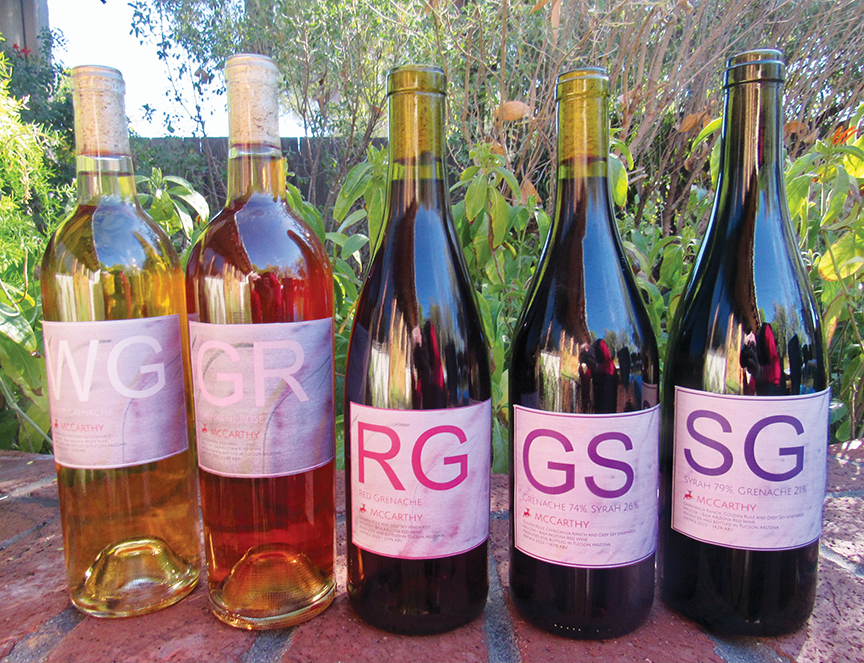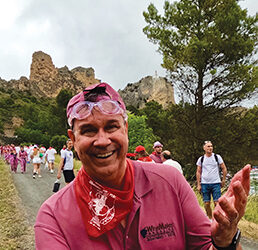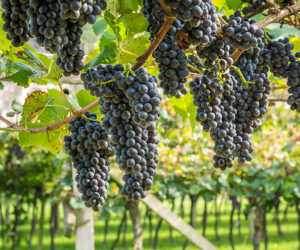I have used Grenache in my home winemaking in the past for rosé and as a blending grape with Syrah. Used in blends, it has always seemed to enliven the mouthfeel and acidity of the wine, and has been perfect for rosé. I became enraptured with the idea of using Grenache exclusively for one year’s production in 2022 as a way to explore its versatility as white, rosé, and red wines (both varietal and blended with Syrah).

The vineyards of my Grenache are in the Willcox AVA in southeast Arizona, about 80 miles from my home in Tucson. Willcox has an elevation of about 4,500 feet, mostly loam soils, irrigation is from deep wells, and there is a typical diurnal temperature range of 40 °F (22 °C). Temperatures are about 15 °F (8 °C) cooler than in the city. Eighty percent of Arizona’s wine grapes are grown there, and Rhône varietals do quite well.
Following a winery owner’s recommendation, I sourced two clones of Grenache from different vineyards. The Grenaches grown here produce wines light in color and body. I picked them two weeks apart in early September, thus they were processed separately. I harvested the Syrah a week between those two picks. All were picked very early on cool mornings, but by the time I got them home to lower elevation it was too hot to process them, so they were kept cool indoors overnight and crushed early the next morning. Each had good measurements of Brix and acidity, so no adjustments were needed.
Using the saignée method, the Grenaches were run through a destemmer/crusher and then immediately through my press for free-run juice to separate from the skins without any pressure applied. This was fermented as a white wine (WG in the photo) in closed carboys, then the two were blended. The remaining musts soaked seven hours before doing a very gentle pressing for rosé production (GR) and fermented in a carboy. The white and rosé wines were cold-stabilized outdoors in winter for 13 nights, exposed to temperatures in the mid-30s °F (1–3 °C), then covered and insulated by day. The remaining musts were fermented on the skins and then blended for a red Grenache (RG). Despite employing the saignée method of bleeding off some juice early, the red wine was still fairly light in color. The RG and Syrah were processed in typical fashion for red wines, aerobically with frequent punchdowns. After primary fermentation and racking, the reds went through malolactic fermentation with medium toast French oak cubes added.
Following racking, my intent was to bottle some as red Grenache and do two red blends, one Grenache-dominant and the other Syrah-dominant, to see how the different amounts of Grenache would impact them. In both cases the amounts of Syrah added significantly deepened the wines’ color and body. The 74% Grenache/26% Syrah (GS) comes off as a very enriched Grenache. The 79% Syrah/21% Grenache (SG) is an enlivened Syrah.
I had fun with the labels, painting watercolor backgrounds and using the lettering colors to indicate the wine colors. The reds are too young yet to open but the white and rosé have been very well received. All were tasted happily at bottling and are well balanced, aromatic, and flavorful.
It was a bit of a risk pinning my hopes on a single variety, but I am really pleased with the results, with the versatility of Grenache, and pleased that once the reds are ready I will have five nice wines to choose from!






